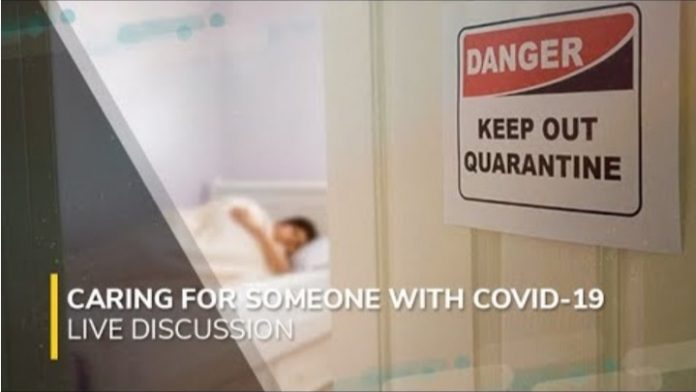
Cases of COVID-19 are spiking around the world and in the U.S.
While most people are coping with COVID-19 at home, a significant portion at higher risk for more serious disease—including people over 65, and those with compromised immune systems or diseases like diabetes or heart disease—are ending up hospitalized, often for long periods of time.
These patients and their families are facing serious challenges on the road to full recovery, and many feel their lives will never be the same.
Recently, three Michigan Medicine experts offered advice for caregiving of patients with COVID-19—from learning how to manage with isolation and quarantine, to hospitalization, to what happens after the initial illness subsides and the long-term recovery journey begins.
The livestream event featured Sheria Robinson-Lane, Ph.D., RN, assistant professor of nursing at the University of Michigan in the department of systems, populations and leadership; Amanda Leggett, Ph.D., research assistant professor in the U-M department of psychiatry, and Jack Iwashyna, M.D., professor in the department of internal medicine’s division of pulmonary and critical care medicine, who works in medical intensive care at both the University of Michigan and the VA Ann Arbor.
They are investigators for the Health Enhanced by Adjusting and Recovering Together (HEART) study, a project collecting the stories of COVID-19 patients and the people who care for them to quickly develop caregiving resources.
Watch the video below, or read through some highlights below from the Q&A (edited for clarity and length):
What should I do to prepare to care for myself or someone in my home that becomes infected with COVID?
Robinson-Lane: The same sorts of things you’d want to have at home if you were to catch a bad cold or the flu are the same sorts of things you want to make sure you have in your home now.
Cough suppressant, something for pain like Tylenol or Pain unless contraindicated. If you have small children, liquid medications, cough drops and any other home remedies.
The other thing people haven’t really thought about is if someone were to get sick, where could you put them?
So you want to start thinking how to isolate somebody in my house to keep them away from everyone else to prevent them from getting sick.
Do I have an extra bathroom, or if we have to share, how can we keep it extra clean? Do we have enough facemasks at home to keep germs from spreading?
You may also think about getting a thermometer that goes under your tongue or a forehead thermometer to provide accurate numbers.
The last thing that people find pretty helpful is a pulse oximeter. One of the problems with COVID is people can get very sick all of a sudden and may not recognize that they need extra support. A pulse oximeter to give you additional information to know that you need to head in to the hospital. More…
Leggett: Another thing to think about is if you need to stay in your home and quarantine do you have those basic necessities to enable me to stay in my home. Also, I’d think about who are my close contacts?
A family member or neighbor outside of my home that may be able to help me with doing a grocery run or helping with my lawn or some of those other things if you or your loved one need to stay in the house.
How do I know it’s time to go to the emergency room if I have COVID-19?
Robinson-Lane: The main things are a fever about 100 degrees or you start to have difficulty breathing.
Anytime you feel you cannot breathe, it’s time to go to the emergency room. This is really critically important if you have any respiratory conditions like asthma, COPD or emphysema.
Families have to pay attention because once folks have difficulty breathing they aren’t necessarily thinking clearly. It can be hard to know if you need to push them to go; you need to if it seems if they are getting confused, or winded as they move around.
It’s best to contact your physician and explain you may have had an exposure to COVID-19 and then talk about the symptoms and be specific that you notice they are having difficulty breathing, increased weakness and that you have taken their temperature with a thermometer, you want to tell them what the temperature is.
And then hopefully you also have a pulse ox and [if] it goes below 90%, you need to head to the hospital. More…
I’ve been hearing about “long haulers” and “long COVID” – people who had the virus months ago but are still feeling not quite right. Is this a real thing and what do we know about it? What kind of care do these patients need?
Iwasyhna: It’s a great question that we don’t entirely know the answers to.
It’s a thing, it’s absolutely a thing, but ‘what kind of thing’ is why in part we’d love for some of you to go to heart.isr.umich.edu and tell us your story. Because frankly the early data has been a little spotty.
We don’t know how many people have symptoms before the virus or because of the economy and there are lots of other challenges going on.
What we do know is that people who’ve had any kind of infection bad enough to be hospitalized (sepsis) or bad enough to cause respiratory failure (or ARDS) can have post-sepsis syndrome or post-critical illness syndrome and it is not limited to people who’ve been in the ICU—and in some cases, even in people who weren’t hospitalized have an enduring range of symptoms that are new and seem like they’re caused by the combination of the virus, the body’s response to the infection and the limitations of care we have and that becomes a slow recovery.
Written by Kelly Malcom.



